Native plants for Michigan landscapes: Part 2 - Shrubs
Native plants are a great addition to the landscape to provide a thrifty, no-nonsense landscape for years to come.
This is Part 2 in a two-part series on Native Trees and Shrubs for the Michigan Landscape. Read Part 1 - Trees.
Planting native trees and shrubs in home landscapes is rapidly increasing in popularity. Native plants can be easily incorporated into a new or existing landscape to provide natural beauty and enhanced habitat for wildlife. When properly selected and placed, native plants also benefit our environment through reduced water use and less need for pesticides and fertilizers. To top it off, native plants can result in lower, long-term maintenance costs, increased plant hardiness and less work.
Below are several native shrubs to incorporate into smaller spaces in the home landscapes. These shrubs are available through your local nurseries and garden centers or online sources, including the Michigan Native Plant Producers Association.
Large shrubs
Common witchhazel (Hamamelis virginiana) – 15 feet. Multi-stemmed, vase-shaped large shrub that can be pruned to a small understory tree. Tolerates diverse site conditions, excluding wet sites. Bears yellow, ribbon-like flowers in late fall when no other plants are blooming. Leaves are clear lemon-yellow in fall. Best in moist, shady locations.
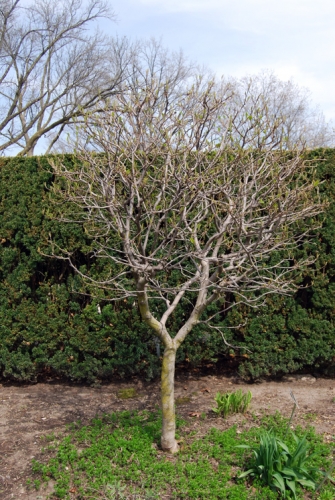
Common witchhazel pruned into a small tree. Photo credit: Mary A. Wilson, MSUE.
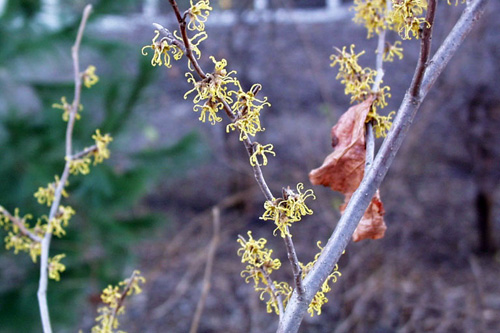
Witchhazel flowers in late October. Photo credit: Paul Wray, Bugwood.org.
Blackhaw viburnum (Viburnum prunifolium) – 12 to 15 feet. One of several native viburnums that add landscape beauty throughout the growing season. Offers creamy-white flower clusters in May and pinkish-rose and edible black fruit in early fall. Fall color is purplish to shining red. Plants develop into a large shrub or can be trained into a small, informal tree. Best in full sun to moderate shade.
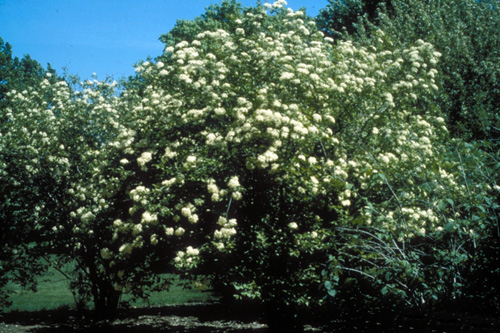
Native blackhaw viburnum provides multiple season of interest. Photo credit: Richard Webb, Bugwood.org.
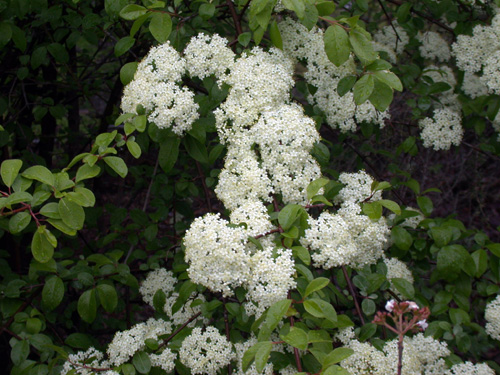
Close up of blackhaw viburnum flowers. Photo credit: Mary A. Wilson, MSUE.
Medium shrubs
Red chokeberry (Aronia arbutifolia) – 6 to 8 feet. Tough, reliable shrubs with abundant white, spring flowers followed by clusters of red fruit in fall. Lustrous green foliage turning brilliant red in fall. Excellent for border or massing, creating a sea of red in fall and winter. Cultivar selections are available.
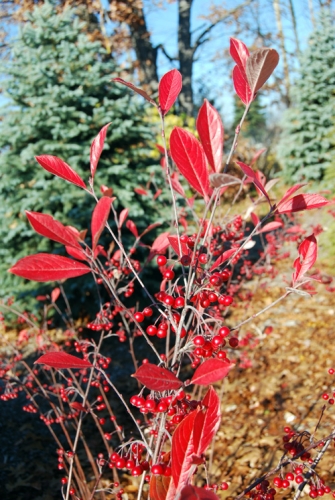
Brilliant fall color and fruit of red chokeberry. Photo credit: Mary A. Wilson, MSUE.
Michigan holly (Ilex verticillata) – 6 to 10 feet. Multi-stemmed deciduous holly with bright red persistent fruits, unless eaten by the birds. Easy to cultivate and flourishes in both wet and dry sites. Excellent for mass effect, shrub borders, water’s edge and wet soils. Both male and female plants needed for fruit display. Sun or partial shade.
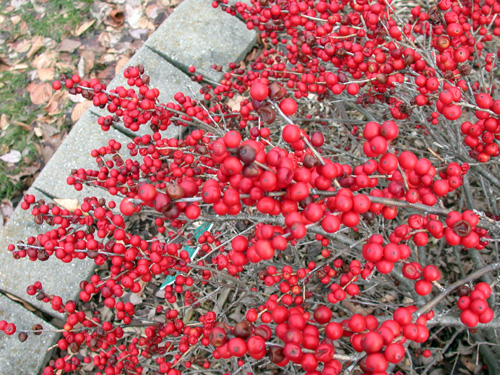
Persistent red fruit of Michigan holly in November. Photo credit: Mary A. Wilson, MSUE.
Common ninebark (Physocarpos opulifolius) – 6 to 9 feet. Rugged plant that flourishes in the toughest conditions. Grows well in sun or shade and varying soil conditions. Pink-white flowers in May and June followed by rose-red fruit that are enjoyed by birds in September and October. Bark exfoliates on older stems, adding to winter interest. Several cultivars are available.
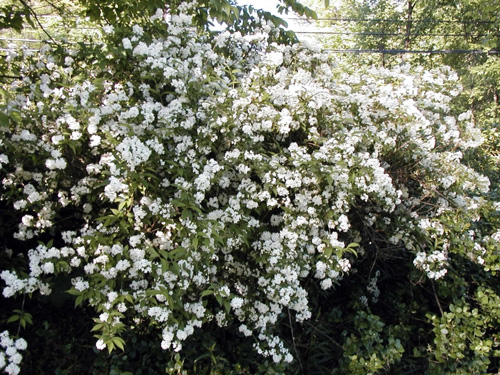
Common ninebark with abundant flowers. Photo credit: The Dow Gardens, Bugwood.org.
Arrowwood vibrunum (Viburnum dentatum) – 8 to 10 feet. Easy to grow multi-stemmed shrub with landscape interest throughout the growing season. Glossy, dark green foliage compliments creamy-white flower clusters in May and dark blue berries in September. Fall color can be an attractive yellow-red-burgundy. Grows in full sun to partial shade. Cultivars available with improved fall color, leaf color and superior fruiting characteristics.

Form and spring flowers of arrowwood viburnum. Photo credit: Mary A. Wilson, MSUE.
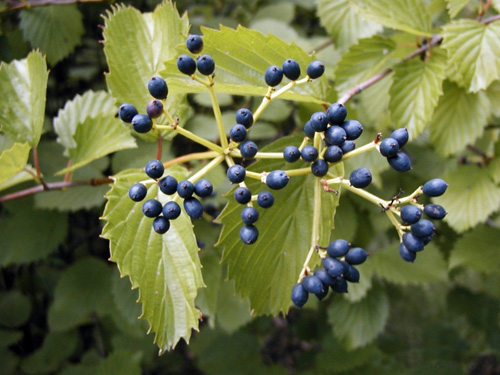
Dark blue fruit of arrowwood viburnum attract several bird species. Photo credit: The Dow Gardens, Bugwood.org.
Small shrubs
New Jersey Tea (Ceanothus americanus) – 3 feet x 3 feet. Low-growing, spreading, durable shrub for mixed borders or foundation plantings. Bears showy, fragrant, white flowers in mid-summer when not many plants are in bloom. Grows best in sandy loams or rocky soils with good drainage. Full sun to light shade. Flowers attract hummingbirds and butterflies and birds eat the seeds.
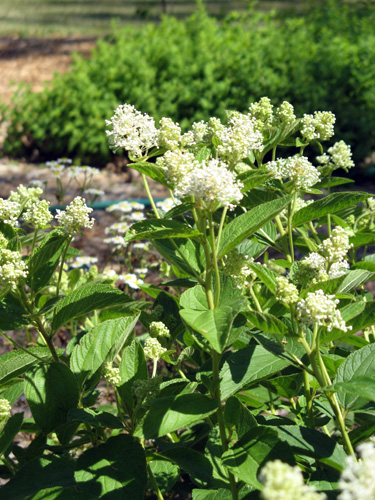
Fragrant early summer flowers of New Jersey Tea. Photo credit: Mary A. Wilson, MSUE.
Buttonbush (Cephalanthus occidentalis) – 5 to 6 feet. Glossy foliage that emerges in shades of red and green, changing to dark green in summer and then yellow-green in autumn. Creamy-white, spherical flower clusters in mid-July attract small butterflies. Thrives in wet soil and full sun. Will not do well in dry soils. Tolerates high pH soils.
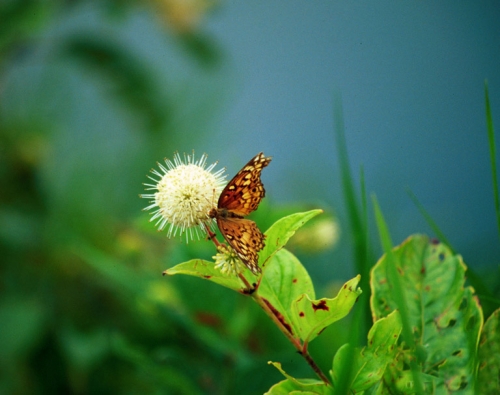
Unique summer flowers of buttonbush. Photo credit: John D. Byrde, Bugwood, org.
Bush honeysuckle (Diervilla lonicera) – 2-4 feet x 4-5 feet. Under-utilized, mound-shaped, spreading plant with excellent cold hardiness. Excellent for mass plantings and slopes. New foliage is bronze-green. Fall color is reddish-bronze. Small, yellow trumpet-shaped flowers in June and July. Does well in sandy and dry soils. Sun or partial shade. Cultivars selections available.
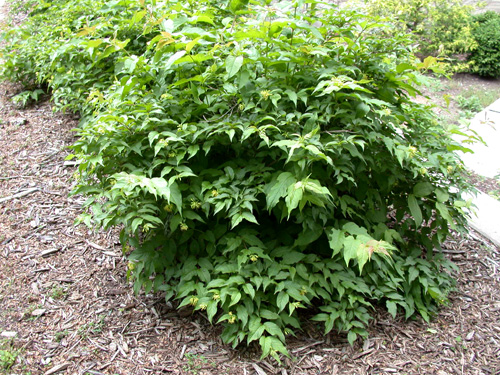
Bush honeysuckle in the summer garden. Photo credit: Mary A. Wilson. MSUE.
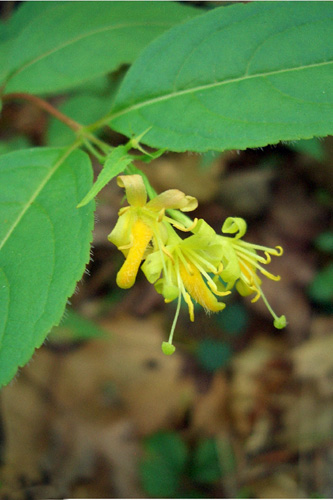
Yellow flowers of bush honeysuckle. Photo credit: Nelson Debarros, USDA.
Shrubby cinquefoil (Potentilla fruticosa) – 3 feet. Small landscape shrub that prospers under many conditions. Leaves unfold in shades of green-gray, changing to bright or dark green in summer and yellow-brown in fall. One of the few plants that flowers all summer with bright yellow blooms, making it a good choice for foundation plantings in sunny locations. Tolerates drought and salt.
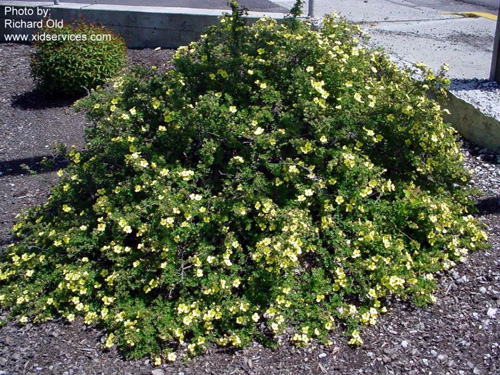
Form and summer flowers of shrubby cinquefoil. Photo credit: Richard Old, Bugwood.org.
Suggestions of several native tree species for larger areas in your landscape can be found in Part 1 of this series.
Related resources on water use or drought
- Excess drying leads to poor mulch performance, Rebecca Finneran, MSU Extension.
- Gardening tips for wise use of your water resources, Mary Wilson, MSU Extension
- Impacts of summer weather on landscape plants, Stephen Fouch, MSU Extension
- Silence of the soaker hoses, Gretchen Voyle, MSU Extension
- Tough plants for tough places: Grasses, Rebecca Finneran, MSU Extension
- Water saving perennials: Carefree and beautiful without the fuss, Rebecca Finneran, MSU Extension
For additional gardening information, call the MSU Extension Lawn and Garden Hotline at 1-888-MSUE-4MI (1-888-678-3464). You can also visit www.migarden.msu.edu.



 Print
Print Email
Email